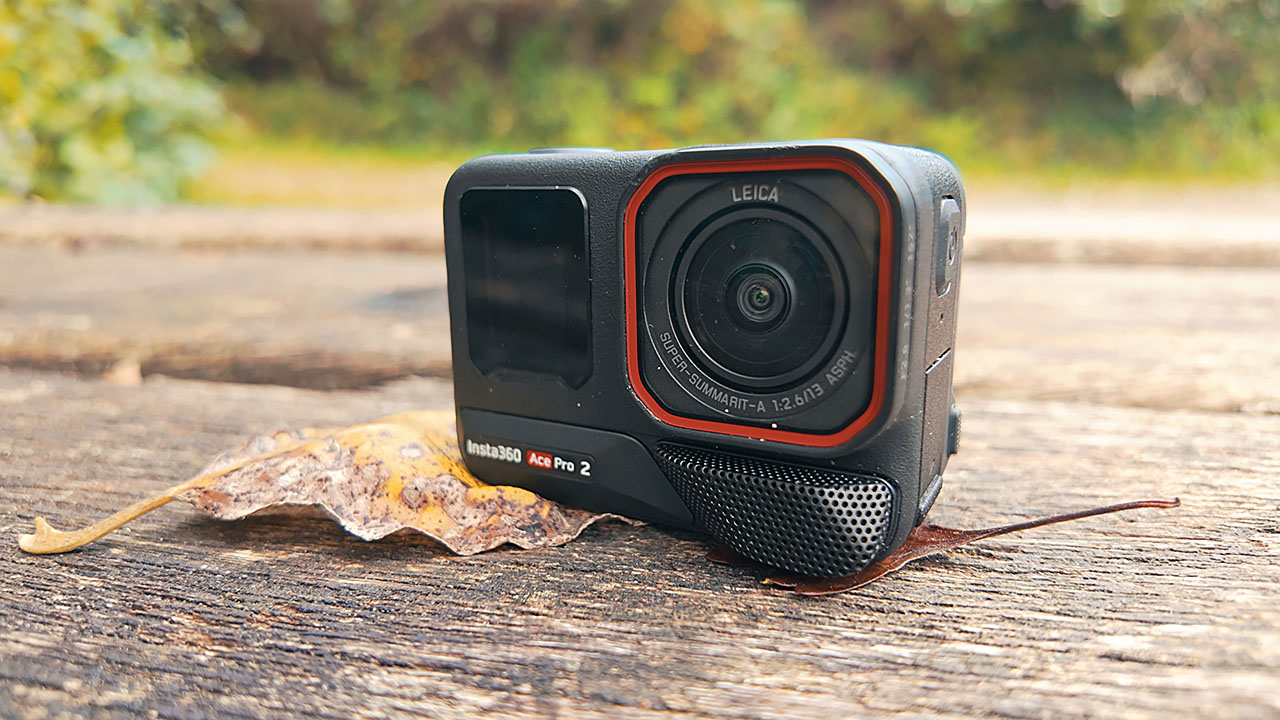
Insta360's Ace Pro 2 takes on board the criticisms of the first camera and gives us a device that demonstrates just how advanced small cameras have become.
It doesn't seem like five minutes ago that I reviewed the first Ace Pro camera from Insta360. In fact, it's not even a year. But, it seems that Insta360 wanted to capitalise on a time of year when both GoPro and DJI also announced their new wares.
When the Ace Pro was released, I liked it as a well-designed and thought-out camera, but it had some limitations when it came to using it for first person action sports; namely the limited field of view from the lens.
So, what's different in the Ace Pro 2? For starters, there's a brand new Leica-designed lens, which not only equals rivals, but beats them with a 157-degree FOV. The lens protector is now removable, making it easy to replace in the case of damage. There's an additional 5nm image processing chip on top of the original AI chip, which gives the Ace Pro 2 a huge advantage in some scenarios. There's a physical removable audio wind filter, which is a world first for this type of camera. The flip-up LCD screen has been increased in size, and the device as a whole has been made more rugged and able to withstand whatever the environment throws at it better.
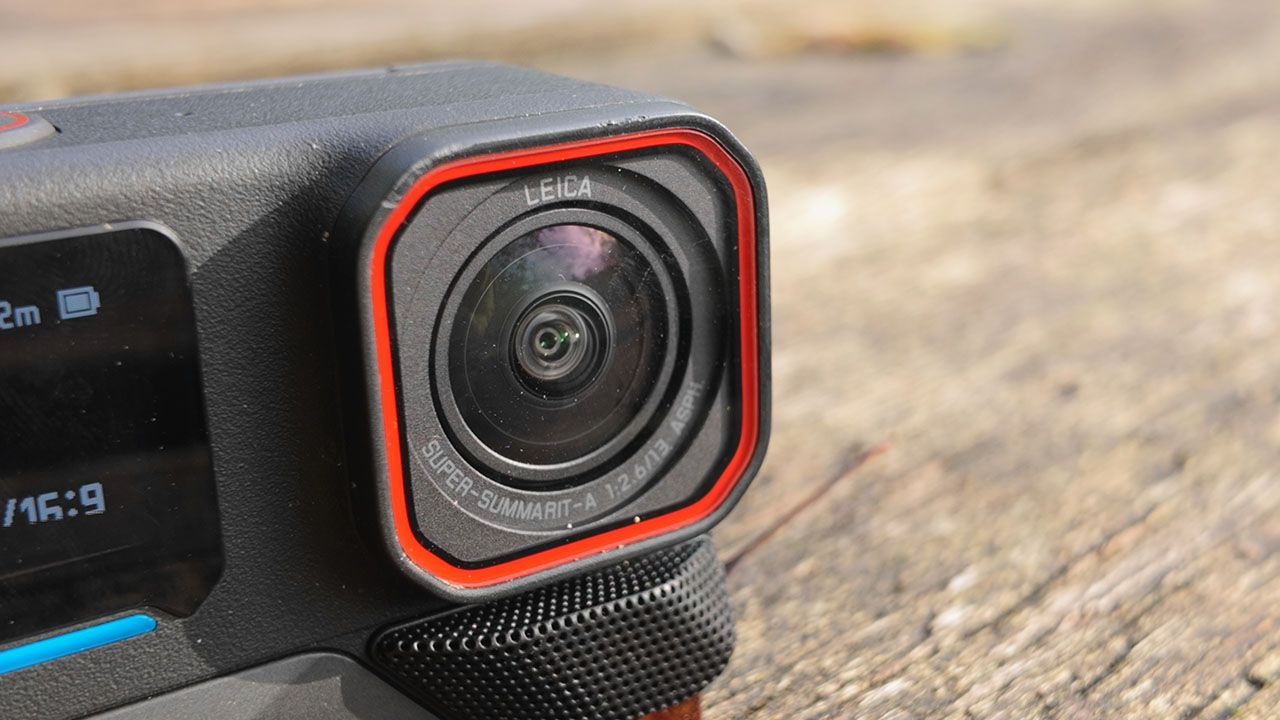
The new Leica designed lens is a big improvement over the previous camera
First impressions
The build quality on Insta360's cameras always impresses me. The whole look of the Ace Pro 2 is just great to gawp at. It feels good in the hand, too, although it is the largest and heaviest of the flagship action cameras at the moment. That said, it looks and feels 'premium'. The flip-up LCD, which you can use to shoot self-shooting vlog style shots, feels reassuringly rugged. Insta360 has made efforts to make the hinge mechanism even more sturdy than the original, which was already pretty darn solid to begin with.
Start-up time for the camera is pretty fast at around 3 seconds, which is ever so slightly faster than the GoPro HERO13 Black, but not as fast as the quite instantaneous power-up of the DJI Action 5 Pro.
The new, larger LCD display has a higher pixel density than the previous camera, and it's also brighter, too. It's easy to see in outdoor sunlight, and it makes shooting vlogging-style shots a pleasure. The only limitation is that you need to physically flip it up, whereas rival cameras have a permanent front screen. That said, it's much easier to see your framing than the tiny screens of its rivals.
On another note with regard to vlogging, while the new lens has been designed to improve the close focusing ability, you will still need to be careful of the distance you hold the camera to ensure that you are in sharp focus.
The user interface is very clear and easy to use, as well as being super responsive. In fact it would appear to be the fastest and most responsive UI of any of the current flagship action cameras, with similar response times to a good smartphone. Another thing I like about it is the haptic feedback. As you scroll through options and select them, you get a subtle haptic feedback from the camera, adding to the feeling of solidity.

The removable wind filter. Every action camera should have one!
The haptic feedback also features when the camera turns on and off, with a short buzz signifying the camera powering up, and a longer one on power down. This is a unique feature, and one with a very practical use. When action cameras are used on a helmet mount, it isn't easy to know what the camera is doing, particularly in loud environments such as in and around whitewater. The haptic feedback vibrates through the helmet, so you can feel what the camera is doing. It's something that other companies should take note of.
The base of the camera features the same magnetic clip mount system as the original Ace Pro. I've been using this extensively, and I fully trust it. One thing of note here, is that the GoPro HERO13 has the most versatility in terms of the camera having the traditional foldable fingers, a 1/4" screw thread, and a magnetic clip system all in one. While the Ace Pro 2 body itself only features the clip mount interface, Insta360 does supply a mount base that features all of those mounting options on it, so it is easy to adapt the Ace Pro 2 for a similar amount of versatility.
Audio
Before I come to the image side of things, it's important to talk about audio. Pretty much all action cameras through the ages have been, let's be charitable about this, less than stellar when it comes to audio.
Various manufacturers have implemented automatic microphone selection based upon which one has less wind noise, as well as in-camera digital wind reduction; none of which has ever given a convincing result. The Ace Pro 2 features something that really should be mandatory on all action cameras, and should have been from the very beginning! A physical windshield.
This features quite prominently on the front of the camera, and it isn't recommended for underwater use, but it finally solves an issue that has plagued these types of cameras for years. It doesn't get rid of all wind noise, but it is a huge improvement over any other action camera out there. You can now finally ride a mountain bike downhill and do a commentary, secure in the knowledge that your audience will hear what you are saying, loud and clear.
In fact, the audio pickup on the camera is so good that from the average vlogging distance it sometimes sounds almost as good as a lav mic. The camera can perform some 'voice focus' processing, which does a pretty darn good job of eliminating background sounds such as traffic without the usual metallic sounding side effects that plagued cameras of the past.
If you do want to use an external mic such as the DJI Mic 2, you can interface it via Bluetooth, which gives the usual 16Khz sound quality. Or, if you have the DJI Mic 2 receiver, you can plug this into the camera and get full quality wireless audio from the system. So, while the Mic 2 won't connect in the same seamless way as it does with the Action 5 Pro, you can still use the system to get full quality audio if you own the receiver.
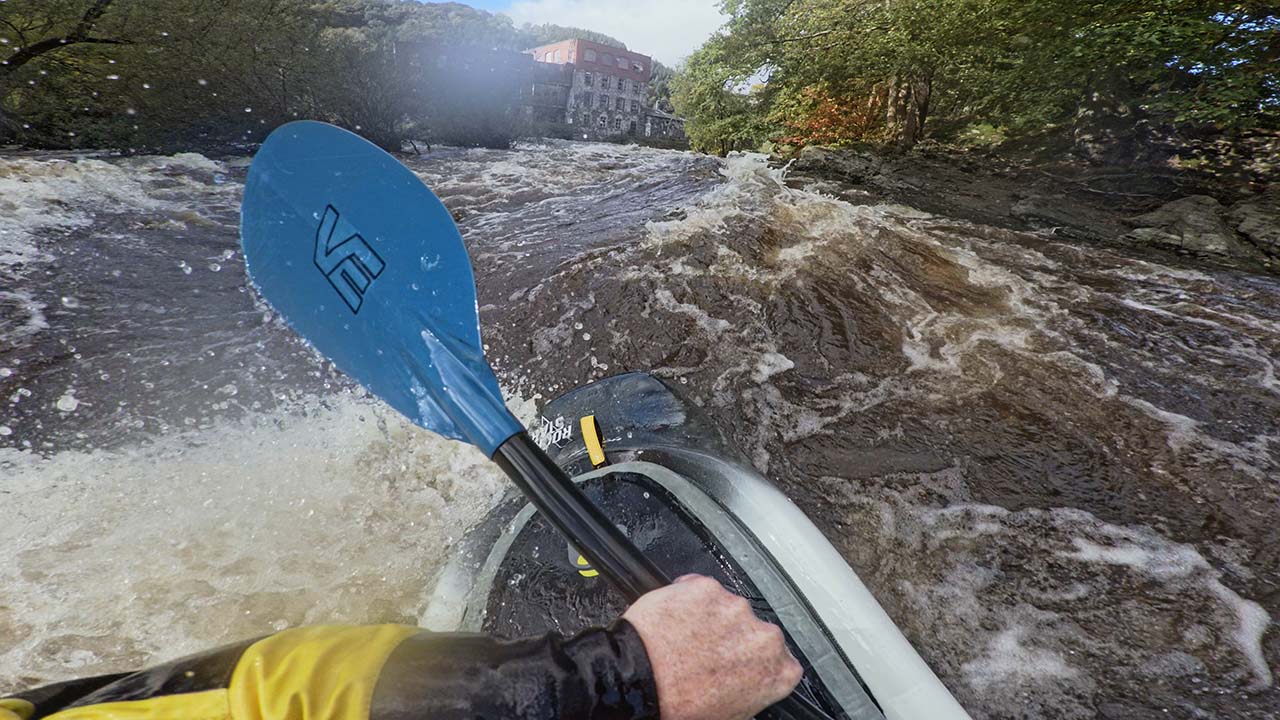
The wide angle lens gives a great view for POV, although the new I-Log mode needs some improvement.
Using the Ace Pro 2 for action
Okay, so what's it like using the camera for action sports, and what's the image quality like? Well, the new lens makes POV-style shots far more immersive than any of Insta360's previous non-360 action cameras. The only way to get a wider shot is either with a 360 camera or to use the HERO13's Ultra Wide Lens Mod. There's not quite as much height as the HERO13 in the 8x7 mode, but that's nitpicking. Finally, I'm glad to say that Insta360 has nailed it this time.
Not only that, but the lens also produces much more pleasing lens flare than either the DJI or the GoPro. I suppose we should expect that though, given the Leica connection.
The Ace Pro 2 offers several picture profiles, including some Leica developed ones. But, for the most part, users will be using the standard profile. By default, this comes with the HDR tone mapping system turned on, which gives a very vivid 'hyper real' look to things. It might be a bit much for some, but it can be switched off.
Usually I recommend dialling the sharpness setting down to low, with any sharpening being performed in post. But, in this case I do feel like the Ace Pro 2 is much more suited to getting the shot straight out of the camera, and I'll come to my reasons why in a moment. Setting the sharpness to medium will give you a sharp image without looking too overtly digital.
In a first for Insta360, the Ace Pro 2 features the company's first dedicated log mode, called I-Log. It's a step in the right direction, but it is a slightly strange implementation. I have found the footage to be lacking in definition and detail in this mode, and it is hobbled by the lack of a 10-bit recording system. Log really does need 10-bit colour since it is a tonal compression system, and I think some more development needs to be done in terms of how the logarithmic function is defined. There's something not quite 'right' about it. So, while I commend Insta360 for giving a log option, it does need some work before it can compete with competitors.
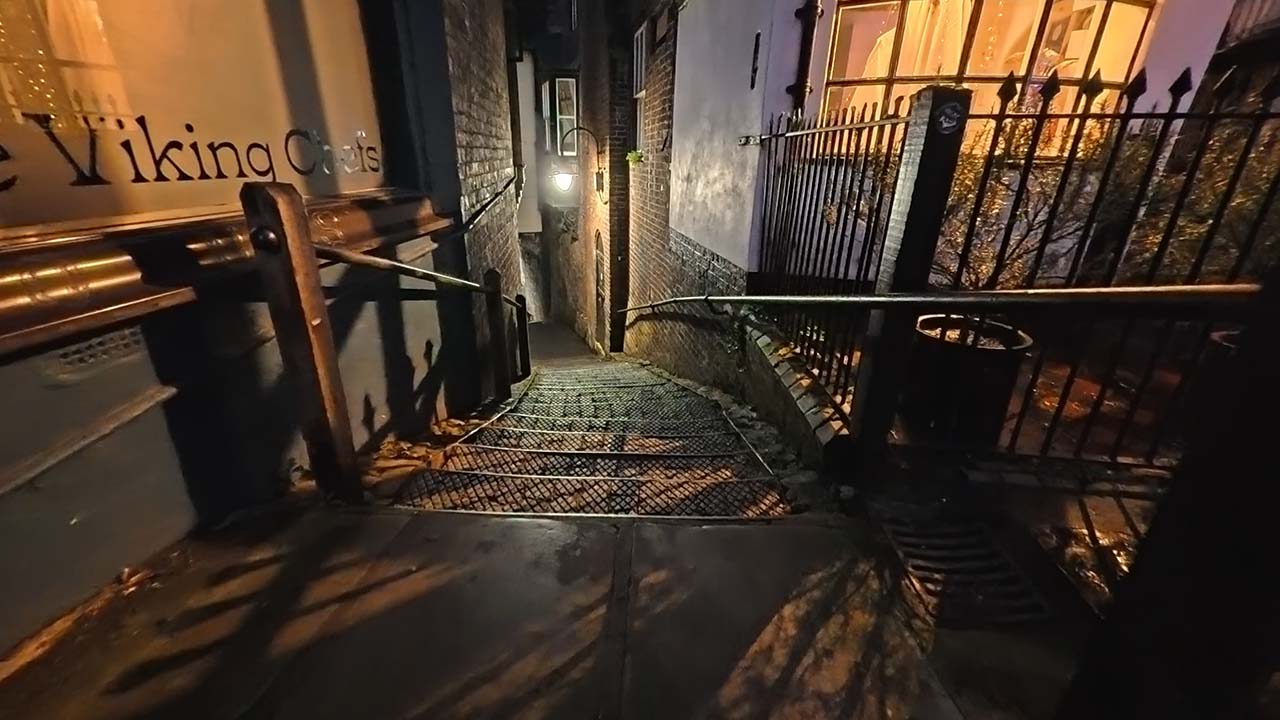
The Pure Video mode on the Ace Pro 2 gives staggering low light performance. The screen grab above has had no post adjustment.
Low light
Low light is an area in which the Ace Pro 2 pretty much decimates the competition. The DJI Action 5 Pro is no slouch in this department, either, and in fact the two cameras share the same sensor. However, the Ace Pro 2 with its two processors, is clearly doing the better job here. Where the Action 5 Pro's SuperNight mode features quite prominent sharpening halos, the Ace Pro 2's Pure Video mode produces a much more natural looking image.
It's not perfect by any means, with huge amounts of advanced noise reduction being applied resulting in some differing artefacts here and there. But, it does give you a very usable image given the circumstances in which you'd find yourself using it, and for a camera of this type it's a pretty staggering achievement. GoPro has yet to implement any form of low light system, and I've tried to see if it's possible to use software such as Topaz and Neat Video to try and get the GoPro's image to match it, but to no avail.
Low light performance even in the standard mode is also pretty good, with the camera handling dim environments, such as under tree cover in forests, while still maintaining good stabilisation. Quite simply, if you are shooting a lot of low light stuff, the Ace Pro 2 is what you need.
Battery life and reliability
Battery life on the Ace Pro 2 doesn't reach the giddying heights of the Action 5 Pro, although it is pretty respectable at around 1.5hrs of 4K footage. But, given the amount of processing the camera is performing, that's pretty impressive.
Reliability-wise, I have had no issues. The only thing I would note in a watersports environment is that the LCD screen seems to be super responsive to water droplets hitting it. Whilst attempting some surfing ('attempting' being the operative word), the camera did stop recording a few times as a water droplet hit the stop record icon on the screen. So, it's important to put the screen into lock mode if you are using the Ace Pro 2 in a watersports scenario.
Something else to note is that it isn't possible to safety tether to the camera body. You can tether to the mount, but in some high impact situations the mount itself can be the thing that breaks, so you really do want to be able to tether directly to the camera. GoPro produces silicone cases that have a tether built in. It would be good to see Insta360 produce something similar, or design in a tether point to the camera body, since accessories such as floaty cases make the camera big and unwieldy for helmet mounting.
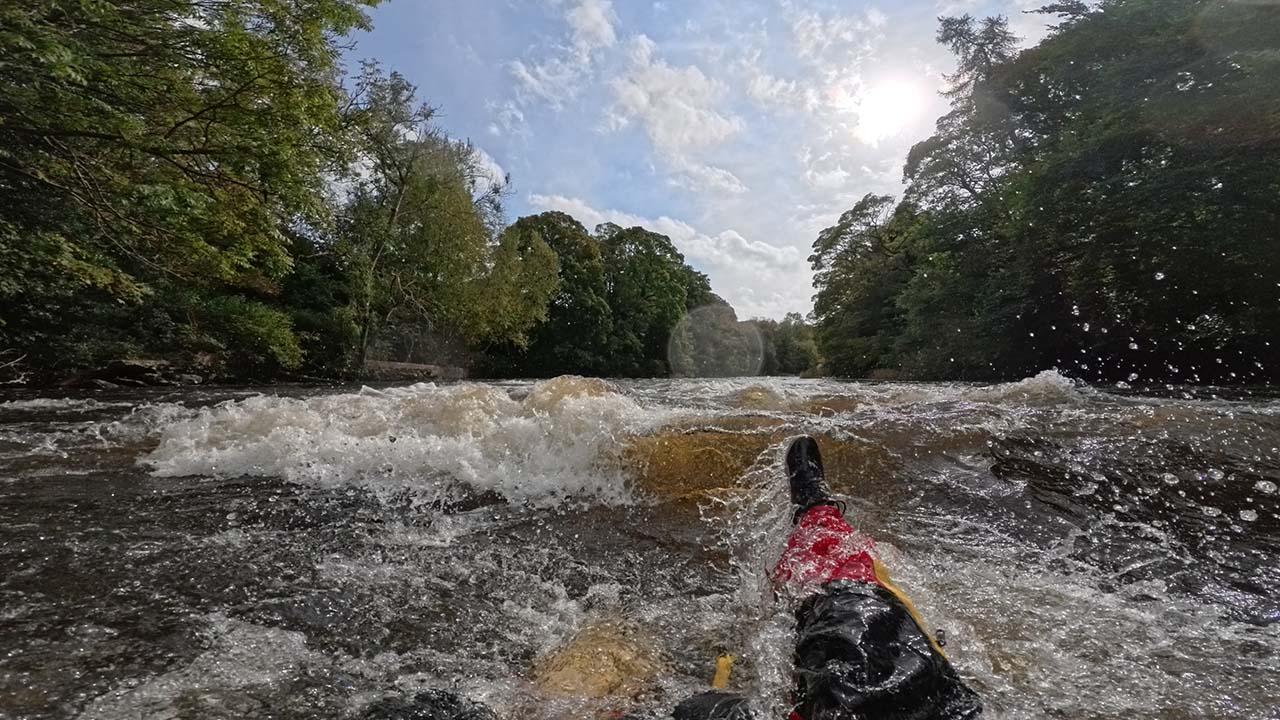
The Standard colour profile does look 'hyper real' in some high contrast situations, but the HDR tone mapping can be turned off for a more natural looking image.
Conclusions
The Insta360 Ace Pro 2 is a very well-thought-out and produced camera. In its current form it would suit people who want a vibrant image right out of the camera that they can send straight through to social media. The lack of 10-bit recording does limit it somewhat compared to competitors for grading and matching to other cameras, although it does feature timecode for multi-camera syncing.
The new lens is a massive improvement over the previous cameras for POV use, and the camera as a whole is easy to use, super responsive, and reliable in use. So, if you aren't so bothered with grading and image tinkering, the Ace Pro 2 is certainly up there with the competition. If the log mode and 10-bit recording could be sorted out, it would be a very difficult camera to beat indeed.
The Ace Pro 2 is available now for £389 for the standard bundle and £409 for the dual battery package. Other packages for different creative uses are also available.
tl;dr
- Insta360's Ace Pro 2 improves upon the original with a new Leica-designed lens offering a 157-degree field of view, a removable lens protector, and enhanced image processing capabilities.
- The camera features a larger, higher pixel density flip-up LCD screen that's brighter and easier to use for vlogging, though it requires manual flipping to access.
- The user interface is highly responsive with haptic feedback, allowing users to feel the camera's actions, which is particularly useful in loud environments.
- A unique physical wind filter addresses the audio quality issues commonly faced by action cameras, making the Ace Pro 2 stand out in terms of sound performance.


Comments